2008: Iraqi Forces Arm and Their Present Situation-
Further information: 2008 in Iraq
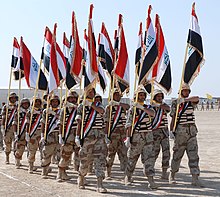
Soldiers of the 3rd Brigade, 14th Iraqi Army division graduate from basic training.

2nd Iraqi Brigade's Iraqi T-72 tanks passes in review during a ceremony marking the assumption of responsibility at Camp Taji.
Throughout 2008, U.S. officials and independent think tanks began to point to improvements in the security situation, as measured by key statistics. According to the U.S. Defense Department, in December 2008 the "overall level of violence" in the country had dropped 80% since before the surge began in January 2007, and the country's murder rate had dropped to pre-war levels. They also pointed out that the casualty figure for U.S. forces in 2008 was 314 against a figure of 904 in 2007.
According to the Brookings Institution, Iraqi civilian fatalities numbered 490 in November 2008 as against 3,500 in January 2007, whereas attacks against the coalition numbered somewhere between 200 and 300 per week in the latter half of 2008, as opposed to a peak of nearly 1,600 in summer 2007. The number of Iraqi security forces killed was under 100 per month in the second half of 2008, from a high of 200 to 300 in summer 2007.
Meanwhile, the proficiency of the Iraqi military increased as it launched a spring offensive against Shia militias which Prime Minister Nouri al-Maliki had previously been criticized for allowing to operate. This began with a March operation against the Mehdi Army in Basra, which led to fighting in Shia areas up and down the country, especially in the Sadr City district of Baghdad. By October, the British officer in charge of Basra said that since the operation the town had become "secure" and had a murder rate comparable to Manchester in England. The U.S. military also said there had been a decrease of about a quarter in the quantity of Iranian-made explosives found in Iraq in 2008, possibly indicating a change in Iranian policy.
Iraq War-
This article is about the war that began in 2003. For other uses, see Iraq war .
Further information: 2003 invasion of Iraq and Post-invasion Iraq
| ||||||||||||||||||||||||||||||||||
| ||||||||||||||||||||||||||||||||||
The Iraq War, the Second Gulf War and Operation Iraqi Freedom) was a military campaign that began on March 20, 2003, with the invasion of Iraq by a multinational force led by troops from the United States under the administration of President George W. Bush and the United Kingdom under the Prime Minister Tony Blair.
Prior to the invasion, the governments of the United States and the United Kingdom asserted that the possibility of Iraq employing weapons of mass destruction (WMD) threatened their security and that of their coalition/regional allies. In 2002, the United Nations Security Council passed Resolution 1441 which called for Iraq to completely cooperate with UN weapon inspectors to verify that it was not in possession of weapons of mass destruction and cruise missiles. The United Nations Monitoring, Verification and Inspection Commission Head weapons inspector Hans Blix advised the UN Security Council that while Iraq's cooperation was "active", it was not "unconditional" nor "immediate". Iraq's declarations with regards to weapons of mass destruction could not be verified at the time, but unresolved tasks concerning Iraq's disarmment could be completed in "not years, nor weeks, but months". (UNMOVIC) was given access by Iraq under provisions of the U.N. resolution but found no evidence of weapons of mass destruction. Additional months of inspection to conclusively verify Iraq's compliance with the U.N. disarmament requirements were not undertaken.
Following the invasion, the U.S.-led Iraq Survey Group concluded that Iraq had ended its nuclear, chemical, and biological programs in 1991 and had no active programs at the time of the invasion but that Iraq intended to resume production once Iraq sanctions were lifted. Although some degraded remnants of misplaced or abandoned chemical weapons from before 1991 were found, they were not the weapons which had been the main argument to justify the invasion. Some U.S. officials also accused Iraqi President Saddam Hussein of harboring and supporting al-Qaeda, but no evidence of a meaningful connection was ever found. Other reasons for the invasion included Iraq's financial support for the families of Palestinian suicide bombers, Iraqi government human rights and an effort to spread democracy to the country. abuse,
In late February 2009, newly elected U.S. President Barack Obama announced an 18-month withdrawal window for combat forces, with approximately 50,000 troops remaining in the country "to advise and train Iraqi security forces and to provide intelligence and surveillance". General Ray Odierno, the top U.S. military commander in Iraq, said he believes all U.S. troops will be out of the country by the end of 2011, while U.K. forces ended combat operations on April 30, 2009. Iraqi Prime Minister Nouri al-Maliki has said he supports the accelerated pullout of U.S. forces. In a speech at the Oval Office on 31 August 2010 Obama declared "the American combat mission in Iraq has ended. Operation Iraqi Freedom is over, and the Iraqi people now have lead responsibility for the security of their country." Beginning September 1, 2010, the American operational name for its involvement in Iraq changed from "Operation Iraqi Freedom" to "Operation New Dawn." The remaining 50,000 U.S. troops are now designated as "advise and assist brigades" assigned to non-combat operations while retaining the ability to revert to combat operations as necessary. Two combat aviation brigades also remain in Iraq.
UN weapons inspections resume-
The issue of Iraq's disarmament reached a crisis in 2002–2003, when Bush demanded a complete end to alleged Iraqi production of weapons of mass destruction and full compliance with UN Security Council Resolutions requiring UN weapons inspectors unfettered access to suspected weapons production facilities. The UN had prohibited Iraq from developing or possessing such weapons after the Gulf War and required Iraq to permit inspections confirming compliance. During inspections in 1999, Iraq alleged that UN inspectors included U.S. intelligence agents that supplied the U.S. with a direct feed of conversations between Iraqi security agencies as well as other information. This was confirmed by the New York Times and the Wall Street Journal.
During 2002, Bush repeatedly warned of military action unless inspections were allowed to progress unfettered. In accordance with UN Security Council Resolution 1441 Iraq reluctantly agreed to new inspections in late 2002. The weapons inspections did not uncover any WMD in Iraq. Shortly before the invasion Hans Blix, the lead weapons inspector, advised the UN Security Council that Iraq was cooperating with inspections and that the confirmation of disarmament through inspections could be achieved in a short period of time if Iraq remained cooperative.
Preparations for war-
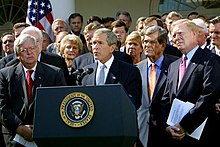
President George Bush, surrounded by leaders of the House and Senate, announces the Joint Resolution to Authorize the Use of United States Armed Forces Against Iraq, October 2, 2002.
During 2002 the amount of ordnance used by British and American aircraft patrolling the no-fly zones of Iraq increased compared to the previous years and by August had "become a full air offensive". Tommy Franks, the allied commander, later stated that the bombing was designed to "degrade" the Iraqi air defense system before an invasion.
In October 2002 former U.S. President Bill Clinton warned against pre-emptive military action against Iraq. Speaking in the U.K. on a Labour Party conference he said: "As a preemptive action today, however well-justified, may come back with unwelcome consequences in the future. And because I don't care – and I've done this. I've ordered these kinds of actions. I don't care how precise your bombs and your weapons are, when you set them off, innocent people will die."

Protest in London, 2002
On January 20, 2003, French Foreign Minister Dominique de Villepin declared "we believe that military intervention would be the worst solution." Meanwhile anti-war groups across the world organised public protests. According to French academic Dominique Reynié, between January 3 and April 12, 2003, 36 million people across the globe took part in almost 3,000 protests against war in Iraq, with demonstrations on February 15, 2003, being the largest and most prolific.
In February 2003, the U.S. Army's top general, Eric Shinseki, told the Senate Armed Services Committee that it would take "several hundred thousand soldiers" to secure Iraq. Two days later, U.S. Defense Secretary Donald Rumsfeld said the post-war troop commitment would be less than the number of troops required to win the war, and that "the idea that it would take several hundred thousand U.S. forces is far from the mark." Deputy Defense Secretary Paul Wolfowitz said Shineski's estimate was "way off the mark," because other countries would take part in an occupying force.
In March 2003, Hans Blix reported that "No evidence of proscribed activities have so far been found" in Iraq, saying that progress was made in inspections which would continue. He estimated the time remaining for disarmament being verified through inspections to be "months". But the U.S. government announced that "diplomacy has failed", and that it would proceed with a coalition of allied countries—named the "coalition of the willing"—to rid Iraq of its alleged WMD. The U.S. government abruptly advised U.N. weapons inspectors to leave Baghdad immediately.
There were serious legal questions surrounding the launching of the war against Iraq and the Bush Doctrine of preemptive war in general. On September 16, 2004, Kofi Annan, the Secretary General of the United Nations, said of the invasion, "I have indicated it was not in conformity with the UN Charter. From our point of view, from the Charter point of view, it was illegal."
In November 2008 Lord Bingham, the former British Law Lord, described the war a serious violation of international law, and accused Britain and the U.S. of acting like a "world vigilante". He also criticized the post-invasion record of Britain as "an occupying power in Iraq". Regarding the treatment of Iraqi detainees in Abu Ghraib, Bingham said: "Particularly disturbing to proponents of the rule of law is the cynical lack of concern for international legality among some top officials in the Bush administration." In July 2010, Deputy Prime Minister of the UK Nick Clegg, in an official PMQs session in Parliament, condemned the invasion of Iraq as illegal.
2003: Invasion-
Main articles: 2003 invasion of Iraq, 2003 in Iraq, 2003 Iraq war timeline, and List of people associated with the 2003 invasion of Iraq
See also: Coalition military operations of the Iraq War and Iraq War order of battle
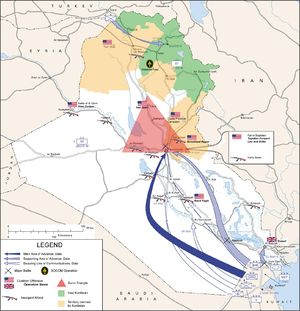
Map of the invasion routes and major operations/battles of the Iraq War as of 2007.

M1 Abrams tank fires its 120mm cannon at Iraqi forces during fighting in Al-Faw peninsula near Umm Qasr, 23 March 2003.

Destroyed remains of Iraqi Tanks near Al Qadisiyah, Iraq during Operation Iraqi Freedom.
The first Central Intelligence Agency invasion team entered Iraq on July 10, 2002. This team was composed of members of the CIA's Special Activities Division and was later joined by members of the U.S. military's elite Joint Special Operations Command (JSOC). Together, they prepared for the invasion of conventional forces. These efforts consisted of persuading the commanders of several Iraqi military divisions to surrender rather than oppose the invasion, and to identify all of the initial leadership targets during very high risk reconnaissance missions.
Most importantly, their efforts organized the Kurdish Peshmerga to become the northern front of the invasion. Together this force defeated Ansar al-Islam in Iraqi Kurdistan before the invasion and then defeated the Iraqi army in the north. The battle against Ansar al-Islam led to the death of a substantial number of militants and the uncovering of a chemical weapons facility at Sargat.
At 5:34 a.m. Baghdad time on March 20, 2003 (9:34 p.m., March 19 EST) the military invasion of Iraq began. The 2003 invasion of Iraq, led by U.S. army General Tommy Franks, began under the codename "Operation Iraqi Liberation", later renamed "Operation Iraqi Freedom", the U.K. codename Operation Telic, and the Australian codename Operation Falconer. Coalition forces also cooperated with Kurdish Peshmerga forces in the north. Approximately forty other governments, the "U.S.-led coalition against Iraq," participated by providing troops, equipment, services, security, and special forces, with 248,000 soldiers from the United States, 45,000 British soldiers, 2,000 Australian soldiers and 194 Polish soldiers from Special Forces unit GROM sent to Kuwait for the invasion. The invasion force was also supported by Iraqi Kurdish militia troops, estimated to number upwards of 70,000.
The stated objectives of the invasion were; end the Hussein regime; eliminate whatever weapons of mass destruction could be found; eliminate whatever Islamist militants could be found; obtain intelligence on militant networks; distribute humanitarian aid; secure Iraq's petroleum infrastructure; and assist in creating a representative but compliant government as a model for other Middle East nations.
The invasion was a quick and decisive operation encountering major resistance, though not what the U.S., British and other forces expected. The Iraqi regime had prepared to fight both a conventional and irregular war at the same time, conceding territory when faced with superior conventional forces, largely armored, but launching smaller scale attacks in the rear using fighters dressed in civilian and paramilitary clothes. This achieved some temporary successes and created unexpected challenges for the invading forces, especially the U.S. military.
Coalition troops launched air and amphibious assault on the Al-Faw peninsula to secure the oil fields there and the important ports, supported by warships of the Royal Navy, Polish Navy, and Royal Australian Navy. The United States Marine Corps' 15th Marine Expeditionary Unit, attached to 3 Commando Brigade and the Polish Special Forces unit GROM attacked the port of Umm Qasr, while the British Army's 16 Air Assault Brigade secured the oilfields in southern Iraq. Polish commandos captured offshore oil platforms near the port, preventing their destruction.

A T72 Asad Babil abandoned after facing the final US thrust into Baghdad.
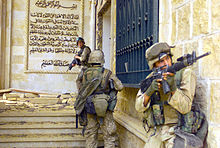
Marines from 1st Battalion 7th Marines enter a palace during the Battle of Baghdad.

A Marine Corps M1 Abrams tank patrols a Baghdad street after its fall in 2003 during Operation Iraqi Freedom.
The heavy armor of the U.S. 3rd Infantry Division moved westward and then northward through the western desert toward Baghdad, while the 1st Marine Expeditionary Force moved more easterly along Highway 1 through the center of the country, and 1 (UK) Armoured Division moved northward through the eastern marshland. The U.S. 1st Marine Division fought through Nasiriyah in a battle to seize the major road junction and nearby Talil Airfield. The United States Army 3rd Infantry Division defeated Iraqi forces entrenched in and around the airfield and bypassed the city to the west in its drive up north through western Iraq.
With the Nasiriyah and Talil Airfields secured in its rear, the 3rd Infantry Division supported by 101st Airborne Division continued its attack north toward Najaf and Karbala, but a severe sand storm slowed the coalition advance and there was a halt to consolidate and make sure the supply lines were secure. When they started again they secured the Karbala Gap, a key approach to Baghdad, then forced the bridges over Euphrates River and the American forces poured through gap on to Baghdad. In the middle of Iraq, the 1st Marine Division fought its way to the eastern side of Baghdad, and prepared for the attack into Badhdad to seize it.
In the north, OIF-1 used the largest special operations force since the successful attack on the Taliban government of Afghanistan just over a year earlier. The Iraqi army was quickly overwhelmed in each engagement it faced with U.S. forces, with the elite Fedayeen Saddam putting up strong, sometimes suicidal, resistance before melting away into the civilian population.
On April 9 Baghdad fell, ending President Hussein's 24-year rule. U.S. forces seized the deserted Ba'ath Party ministries and stage-managed the tearing down of a huge iron statue of Hussein, photos and video of which became symbolic of the event, although later controversial. Not seen in the photos or heard on the videos, shot with a zoom lens, was the chant of the inflamed crowd for al-Sadr, the radical Shiite cleric. In November 2008, Iraqi protesters staged a similar stomping on and burning of an effigy of George W. Bush. The abrupt fall of Baghdad was accompanied by a widespread outpouring of gratitude toward the invaders, but also massive civil disorder, including the looting of public and government buildings and drastically increased crime.
According to the Pentagon, 250,000 short tons (230,000 t) (of 650,000 short tons (590,000 t) total) of ordnance was looted, providing a significant source of ammunition for the Iraqi insurgency. The invasion phase concluded when Tikrit, Hussein's home town, fell with little resistance to the U.S. Marines of Task Force Tripoli and on April 15 the coalition declared the invasion effectively over.
Coalition Provisional Authority and Iraq Survey Group
See also: Iraqi Governing Council, International Advisory and Monitoring Board, CPA Program Review Board, Development Fund for Iraq, and Reconstruction of Iraq

Occupation zones in Iraq as of September 2003.
Shortly after the invasion, which has resulted in the debellatio of Iraq, the multinational coalition created the Coalition Provisional Authority (CPA) سلطة الائتلاف الموحدة, based in the Green Zone, as a transitional government of Iraq until the establishment of a democratic government. Citing United Nations Security Council Resolution 1483 (May 22, 2003) and the laws of war, the CPA vested itself with executive, legislative, and judicial authority over the Iraqi government from the period of the CPA's inception on April 21, 2003, until its dissolution on June 28, 2004.
The CPA was originally headed by Jay Garner, a former U.S. military officer, but his appointment lasted only until May 11, 2003, when President Bush appointed L. Paul Bremer. Bremer served until the CPA's dissolution in July 2004.
Post-invasion phase-
Main article: Post-invasion Iraq, 2003–present
Further information: U.S. list of most-wanted Iraqis and Iraq War insurgent attacks
On May 1, 2003, President Bush staged a dramatic visit to the aircraft carrier USS Abraham Lincoln operating a few miles west of San Diego, California. The visit climaxed at sunset with Bush's now well-known "Mission Accomplished" speech. In this nationally televised speech, delivered before the sailors and airmen on the flight deck, Bush effectively declared victory due to the defeat of Iraq's conventional forces. However, former President Hussein remained at large and significant pockets of resistance remained.

The USS Abraham LincolnMission Accomplished banner. returning to port carrying its
After President Bush's speech, coalition forces noticed a gradually increasing flurry of attacks on its troops in various regions, especially in the "Sunni Triangle". The initial Iraqi insurgents were supplied by hundreds of weapons caches created before the invasion by the Iraqi army and Republican Guard.
Initially, Iraqi resistance (described by the coalition as "Anti-Iraqi Forces") largely stemmed from fedayeen and Hussein/Ba'ath Party loyalists, but soon religious radicals and Iraqis angered by the occupation contributed to the insurgency. The three provinces with the highest number of attacks were Baghdad, Al Anbar, and Salah Ad Din. Those three provinces account for 35% of the population, but are responsible for 73% of U.S. military deaths (as of December 5, 2006), and an even higher percentage of recent U.S. military deaths (about 80%.)
Insurgents use guerrilla tactics including: mortars, missiles, suicide attacks, snipers, improvised explosive devices (IEDs), car bombs, small arms fire (usually with assault rifles), and RPGs (rocket propelled grenades), as well as sabotage against the petroleum, water, and electrical infrastructure.

Seabees of NMCB-15 (Naval Mobile Construction Battalion), on a convoy in Iraq in May 2003
Post-invasion Iraq coalition efforts commenced after the fall of the Hussein regime. The coalition nations, together with the United Nations, began to work to establish a stable, compliant democratic state capable of defending itself from non-coalition forces, as well as overcoming internal divisions.
Meanwhile, coalition military forces launched several operations around the Tigris River peninsula and in the Sunni Triangle. A series of similar operations were launched throughout the summer in the Sunni Triangle. Toward the end of 2003, the intensity and pace of insurgent attacks began to increase. A sharp surge in guerrilla attacks ushered in an insurgent effort that was termed the "Ramadan Offensive", as it coincided with the beginning of the Muslim holy month of Ramadan.
To counter this offensive, coalition forces begin to use air power and artillery again for the first time since the end of the invasion by striking suspected ambush sites and mortar launching positions. Surveillance of major routes, patrols, and raids on suspected insurgents were stepped up. In addition, two villages, including Hussein's birthplace of al-Auja and the small town of Abu Hishma were surrounded by barbed wire and carefully monitored.
Hunting down the Hussein regime-
See also: Supreme Iraqi Criminal Tribunal and Trial of Saddam Hussein

Soldiers with the 65th MP CO Airborne watch as a TOW missile strikes the side of a house of Uday and Qusay Hussein in Mosul, Iraq, 22 July 2003
In the summer of 2003, the multinational forces focused on hunting down the remaining leaders of the former regime. On July 22, a raid by the U.S. 101st Airborne Division and soldiers from Task Force 20 killed Hussein's sons (Uday and Qusay) along with one of his grandsons. In all, over 300 top leaders of the former regime were killed or captured, as well as numerous lesser functionaries and military personnel.
Most significantly, Saddam Hussein himself was captured on December 13, 2003, on a farm near Tikrit in Operation Red Dawn. The operation was conducted by the United States Army's 4th Infantry Division and members of Task Force 121. Intelligence on Saddam's whereabouts came from his family members and former bodyguards.
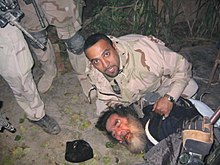
Saddam Hussein being pulled from his hideaway in Operation Red Dawn, 13 December 2003.
With the capture of Hussein and a drop in the number of insurgent attacks, some concluded the multinational forces were prevailing in the fight against the insurgency. The provisional government began training the new Iraqi security forces intended to police the country, and the United States promised over $20 billion in reconstruction money in the form of credit against Iraq's future oil revenues. Oil revenue was also used for rebuilding schools and for work on the electrical and refining infrastructure.
Shortly after the capture of Hussein, elements left out of the Coalition Provisional Authority began to agitate for elections and the formation of an Iraqi Interim Government. Most prominent among these was the Shia cleric Grand Ayatollah Ali al-Sistani. The Coalition Provisional Authority opposed allowing democratic elections at this time. The insurgents stepped up their activities. The two most turbulent centers were the area around Fallujah and the poor Shia sections of cities from Baghdad (Sadr City) to Basra in the south.
 Polish GROM forces in sea operations during Operation Iraqi Freedom. |  May 18, 2004: Staff Sgt. Kevin Jessen checks the underside of two anti-tank mines found in a village outside Ad Dujayl in the Sunni Triangle. |  Delta Force of Task Force 20 alongside troops of 3rd Battalion, 327th Infantry Regiment, at Uday Hussain and Qusay Hussein's hideout. |  House of Uday and Qusay Hussein in Mosul, Iraq destroyed by U.S. forces, July 31, 2003]] |
2004: Insurgency expands-
Main article: 2004 in Iraq
- See also: Military operations of the Iraq War for a list of all Coalition operations for this period, 2004 in Iraq, Iraqi coalition counter-insurgency operations, History of Iraqi insurgency, United States occupation of Fallujah, Iraq Spring Fighting of 2004

Coalition Provisional Authority director L. Paul Bremer signs over sovereignty to the appointed Iraqi Interim Government, June 28, 2004.
The start of 2004 was marked by a relative lull in violence. Insurgent forces reorganised during this time, studying the multinational forces' tactics and planning a renewed offensive. However, violence did increase during the Iraq Spring Fighting of 2004 with foreign fighters from around the Middle East as well as al-Qaeda in Iraq (an affiliated al-Qaeda group), led by Abu Musab al-Zarqawi helping to drive the insurgency.
As the insurgency grew there was a distinct change in targeting from the coalition forces towards the new Iraqi Security Forces, as hundreds of Iraqi civilians and police were killed over the next few months in a series of massive bombings. An organized Sunni insurgency, with deep roots and both nationalist and Islamist motivations, was becoming more powerful throughout Iraq. The Shia Mahdi Army also began launching attacks on coalition targets in an attempt to seize control from Iraqi security forces. The southern and central portions of Iraq were beginning to erupt in urban guerrilla combat as multinational forces attempted to keep control and prepared for a counteroffensive.

A M1 Abrams in Fallujah, fires its main gun into a building to provide suppressive counter fire against insurgents
The offensive was resumed in November 2004 in the bloodiest battle of the war so far: the Second Battle of Fallujah, described by the U.S. military as "the heaviest urban combat (that they had been involved in) since the battle of Hue City in Vietnam." During the assault, U.S. forces used white phosphorus as an incendiary weapon against insurgent personnel, attracting controversy. The 46-day battle resulted in a victory for the coalition, with 95 U.S. soldiers killed along with approximately 1,350 insurgents. Fallujah was totally devastated during the fighting, though civilian casualties were low, as they had mostly fled before the battle.
Another major event of that year was the revelation of widespread prisoner abuse at Abu Ghraib which received international media attention in April 2004. First reports of the Abu Ghraib prisoner abuse, as well as graphic pictures showing U.S. military personnel taunting and abusing Iraqi prisoners, came to public attention from a 60 Minutes II news report (April 28) and a Seymour M. Hersh article in The New Yorker (posted online on April 30.) Military correspondent Thomas Ricks claimed that these revelations dealt a blow to the moral justifications for the occupation in the eyes of many people, especially Iraqis, and was a turning point in the war.
2005: Elections and transitional government-
Further information: 2005 in Iraq and Military transition team
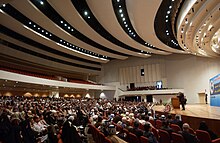
Convention center for Council of Representatives of Iraq – مجلس النواب العراقي / ئهنجومهنی نوێنهرانی عێراق
On January 31, Iraqis elected the Iraqi Transitional Government in order to draft a permanent constitution. Although some violence and a widespread Sunni boycott marred the event, most of the eligible Kurd and Shia populace participated. On February 4, Paul Wolfowitz announced that 15,000 U.S. troops whose tours of duty had been extended in order to provide election security would be pulled out of Iraq by the next month.
February to April proved to be relatively peaceful months compared to the carnage of November and January, with insurgent attacks averaging 30 a day from the prior average of 70.
Hopes for a quick end to the insurgency and a withdrawal of U.S. troops were dashed in May, Iraq's bloodiest month since the invasion. Suicide bombers, believed to be mainly disheartened Iraqi Sunni Arabs, Syrians and Saudis, tore through Iraq. Their targets were often Shia gatherings or civilian concentrations of Shias. As a result, over 700 Iraqi civilians died in that month, as well as 79 U.S. soldiers.
The summer of 2005 saw fighting around Baghdad and at Tall Afar in northwestern Iraq as U.S. forces tried to seal off the Syrian border. This led to fighting in the autumn in the small towns of the Euphrates valley between the capital and that border.
Further information: 2006 in Iraq, Civil war in Iraq, Operation Together Forward, and Provincial Reconstruction Team

Nouri al-Maliki meets with George W. Bush, June 2006
The beginning of 2006 was marked by government creation talks, growing sectarian violence, and continuous anti-coalition attacks. Sectarian violence expanded to a new level of intensity following the al-Askari Mosque bombing in the Iraqi city of Samarra, on February 22, 2006. The explosion at the mosque, one of the holiest sites in Shi'a Islam, is believed to have been caused by a bomb planted by al-Qaeda.
Although no injuries occurred in the blast, the mosque was severely damaged and the bombing resulted in violence over the following days. Over 100 dead bodies with bullet holes were found on February 23, and at least 165 people are thought to have been killed. In the aftermath of this attack the U.S. military calculated that the average homicide rate in Baghdad tripled from 11 to 33 deaths per day. In 2006 the UN described the environment in Iraq as a "civil war-like situation."
Iraq Study Group report and Hussein's execution-Main articles: Iraq Study Group and Execution of Saddam Hussein

Lee Hamilton (left) and James Baker (right) presented the Iraq Study Group Report to George W. Bush on December 6, 2006.
The ISG was led by co-chairs James Baker, a former Secretary of State (Republican), and Lee Hamilton, a former U.S. Representative (Democrat).
The Iraq Study Group Report was released on December 6, 2006. Iraq Study Group, made up of people from both of the major U.S. parties, was led by former U.S. Secretary of State James Baker and former Democratic congressman Lee Hamilton. It concluded that "the situation in Iraq is grave and deteriorating" and "U.S. forces seem to be caught in a mission that has no foreseeable end." The report's 79 recommendations include increasing diplomatic measures with Iran and Syria and intensifying efforts to train Iraqi troops. On December 18, a Pentagon report found that insurgent attacks were averaging about 960 a week, the highest since the reports had begun in 2005.
Coalition forces formally transferred control of a province to the Iraqi government, the first since the war. Military prosecutors charged eight U.S. Marines with the murders of 24 Iraqi civilians in Haditha in November 2005, 10 of them women and children. Four officers were also charged with dereliction of duty in relation to the event.
Saddam Hussein was hanged on December 30, 2006, after being found guilty of crimes against humanity by an Iraqi court after a year-long trial.
The rate of U.S. combat deaths in Baghdad nearly doubled to 3.14 per day in the first seven weeks of the "surge" in security activity, compared to previous period. Across the rest of Iraq it reduced slightly.

An Iraqi woman looks on as U.S. soldiers search the courtyard of her house in Ameriyah, Iraq. Searching houses for weapons is a common counter-insurgency technique used in Iraq.
On August 14, 2007, the deadliest single attack of the whole war occurred. Nearly 800 civilians were killed by a series of coordinated suicide bomb attacks on the northern Iraqi settlement of Qahtaniya. More than 100 homes and shops were destroyed in the blasts. U.S. officials blamed al-Qaeda. The targeted villagers belonged to the non-Muslim Yazidi ethnic minority. The attack may have represented the latest in a feud that erupted earlier that year when members of the Yazidi community stoned to death a teenage girl called Du'a Khalil Aswad accused of dating a Sunni Arab man and converting to Islam. The killing of the girl was recorded on camera-mobiles and the video was uploaded onto the internet.
On September 13, 2007, Abdul Sattar Abu Risha was killed in a bomb attack in the city of Ramadi. He was an important U.S. ally because he led the "Anbar Awakening", an alliance of Sunni Arab tribes that opposed al-Qaeda. The latter organisation claimed responsibility for the attack. A statement posted on the Internet by the shadowy Islamic State of Iraq called Abu Risha "one of the dogs of Bush" and described Thursday's killing as a "heroic operation that took over a month to prepare".

A graph of U.S. troop fatalities in Iraq, the orange and blue months being post-troop surge.
There was a reported trend of decreasing U.S. troop deaths after May 2007, and violence against coalition troops had fallen to the "lowest levels since the first year of the American invasion". These, and several other positive developments, were attributed to the surge by many analysts.
Data from the Pentagon and other U.S. agencies such as the Government Accountability Office (GAO) found that daily attacks against civilians in Iraq remained "about the same" since February. The GAO also stated that there was no discernible trend in sectarian violence. However, this report ran counter to reports to Congress, which showed a general downward trend in civilian deaths and ethno-sectarian violence since December 2006. By late 2007, as the U.S. troop surge began to wind down, violence in Iraq had begun to decrease from its 2006 highs.
Further information: 2009 in Iraq
Transfer of Green Zone-

Aerial view and map of the Green Zone in Baghdad.
On January 1, 2009, the United States handed control of the Green Zone and Saddam Hussein's presidential palace to the Iraqi government in a ceremonial move described by the country's prime minister as a restoration of Iraq's sovereignty. Iraqi Prime Minister Nouri al-Maliki said he would propose January 1 be declared national "Sovereignty Day". "This palace is the symbol of Iraqi sovereignty and by restoring it, a real message is directed to all Iraqi people that Iraqi sovereignty has returned to its natural status," al-Maliki said.
The U.S. military attributed a decline in reported civilians deaths to several factors including the U.S.-led "troop surge", the growth of U.S.-funded Awakening Councils, and Shiite cleric Muqtada al-Sadr's call for his militia to abide by a cease fire.
2010: U.S. drawdown and Operation New Dawn-
Further information: 2010 in Iraq and Withdrawal of U.S. troops from Iraq
U.S. withdrawal-
On February 17, 2010, Secretary of Defense Robert Gates announced that as of September 1, 2010, the name "Operation Iraqi Freedom" would be replaced by "Operation New Dawn".
On 20 June, Iraq's Central Bank was bombed in an attack that left 15 people dead and brought much of downtown Baghdad to a standstill. The attack was claimed to have been carried out by the Islamic State of Iraq. This attack was followed by another attack on Iraq's Bank of Trade building that killed 26 and wounded 52 people.
In late August 2010, insurgents conducted a major attack with at least 12 car bombs simultaneously detonating from Mosul to Basra and killing at least 51. These attacks coincided with the U.S. plans for a withdrawal of combat troops.
| Wikinews has related news: U.S. combat forces pull out of Iraq |
The last U.S. combat brigades departed Iraq in the early morning of August 19, 2010. Convoys of U.S. troops had been moving out of Iraq to Kuwait for several days, and NBC News broadcast live from Iraq as the last convoy crossed the border. While all combat brigades left the country, an additional 50,000 personnel remained in the country to provide support for the Iraqi military.
These troops are required to leave Iraq by 31 December 2011 under an agreement between the U.S. and Iraqi governments. State Dept. spokesman P.J. Crowley stated "We are ending the war.... but we are not ending our work in Iraq, We have a long-term commitment to Iraq."
On August 31, 2010, Obama announced the end of Operation Iraqi Freedom from the Oval Office. In his address, he covered his next year's plan for closing operations in Afghanistan, the role of the United States' soft power, the effect the war has had on the United States economy, and the legacy of American wars.
The United States has paid a huge price to put the future of Iraq in the hands of its people. We have sent our young men and women to make enormous sacrifices in Iraq, and spent vast resources abroad at a time of tight budgets at home. We have persevered because of a belief we share with the Iraqi people—a belief that out of the ashes of war, a new beginning could be born in this cradle of civilization. Through this remarkable chapter in the history of the United States and Iraq, we have met our responsibility. Now, it is time to turn the page.
—President Obama's Address on Iraq, August 31, 2010
On the same day in Iraq, at a ceremony at one of Saddam Hussein's former residences at Al Faw Palace in Baghdad, a number of U.S. dignitaries spoke in a ceremony for television cameras, avoiding overtones of the triumphalism present in US announcements made earlier in the war. Vice President Joe Biden expressed concerns regarding the ongoing lack of progress in forming a new Iraqi government, saying of the Iraqi people that "they expect a government that reflects the results of the votes they cast." Gen. Ray Odierno stated that the new era "in no way signals the end of our commitment to the people of Iraq." Speaking in Ramadi earlier in the day, Gates said that U.S. forces "have accomplished something really quite extraordinary here, [but] how it all weighs in the balance over time I think remains to be seen." When asked by reporters if the seven year war was worth doing, Gates commented that "It really requires a historian's perspective in terms of what happens here in the long run." He noted the Iraq War "will always be clouded by how it began" in regards Saddam Hussein's supposed weapons of mass destruction, which were never confirmed to have existed. Gates continued, "This is one of the reasons that this war remains so controversial at home." On the same day Gen. Ray Odierno was replaced by Lloyd Austin as Commander of US forces in Iraq
However, there has been some controversy over whether the official declaration is accurate, with the issuance of a standards memo from the Associated Press stating "combat in Iraq is not over, and we should not uncritically repeat suggestions that it is, even if they come from senior officials."
From Wikipedia-
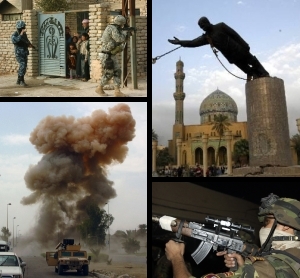
No comments:
Post a Comment